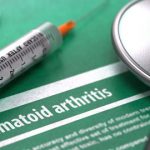Research has found dual-energy computed tomography (DECT) may be a non-invasive and cost-effective option to help rheumatologists more accurately diagnose gout.


MedStar Georgetown Washington Hospital Center: Leen Al Saleh, MD; Ajita Acharya, MD; Elena Obreja, MD; & Akrithi U. Garren, MD |
Research has found dual-energy computed tomography (DECT) may be a non-invasive and cost-effective option to help rheumatologists more accurately diagnose gout.

Cleveland Clinic Foundation Rheumatology Fellowship Program: Saja Almaaitah, MD; Shashank Cheemalavagu, MD; Rupal Shastri, MD; Perry Fuchs, MD; Melany Gonzalez Orta, MD; & James Vondenberg, DO |
As the capabilities of machine learning and artificial intelligence improve, rheumatologists have access to more data than ever, which may enable them to better predict which patients will respond to specific treatments, such as tumor necrosis factor inhibitors.

The Children’s Hospital at Montefiore Pediatric Rheumatology Fellowship Program: Alisha Akinsete, MD; Malki Peskin, MD; & Jessica Perfetto, MD |
Machine learning is a tool that may help pediatric rheumatologists distinguish between different subtypes of juvenile idiopathic arthritis (JIA) and predict treatment response.

Ohio State University Rheumatology Fellowship Program: Nina Couette, DO; Jesse Reisner, DO; & Sheryl Mascarenhas, MD, Fellowship Program Director |
Editor’s note: RheumMadness is the place for everyone crazy about rheumatology to connect, collaborate, compete and learn together. During RheumMadness, rheumatology concepts represent teams that compete against each other in a tournament, much like basketball teams do in the NCAA’s March Madness tournament. In a series for The Rheumatologist, readers will get a chance to…

University of Texas Southwestern Rheumatology Fellowship Program: Kubra Bugdayli, MD; Brett Capel, MD; Yusuf Chao, MD; Melissa DeFoe, MD; Daniel Emesiani, MD; Joad Eseddi, MD; Nagendra Pokala, MD; Komal Patel, MD; Bonnie Bermas, MD; Haidy Galous, MD; Andreas Reimold, MD; & Guillermo Andres Quiceno, MD |
Dalmatians have defects in the renal tubular reabsorption of filtered urate and the hepatic conversion of uric acid to allantoin that may provide unique insights into uric acid homeostasis, with implications for the treatment and management of gout.

Virginia Commonwealth University Rheumatology Fellowship Program: David Shoemaker, MD; Evan Dombrosky, MD; Nima Madanchi, MD; Abhishek Nandan, MD; & Huzaefah Syed, MD |
Spondyloarthropathy is an ancient form of arthritis shared by multiple orders and classes of the animal kingdom. Camarasaurus, a genus of quadrupedal, herbivorous dinosaur, holds the record for the earliest known case of spondyloarthropathy—147 million years ago.

Wake Forest School of Medicine Rheumatology Fellowship Program: Khiem Vu, MD; Alyssa Strazanac, MD; John Herion, DO; & Rami Diab, MD |
Daily living, such as walking, jumping and going up stairs, can be difficult for patients with osteoarthritis (OA). Research on the regenerative limbs of the axolotl and the human ankle provides insights into the potential of this process in humans and its implications for hip, knee and ankle OA.

Residents from the RheumMadness Leadership Team: Michael Macklin, MD, PharmD; Ben Kellogg, MD; Lauren He, MD; & David Leverenz, MD |
According to research, Pim kinases contribute to the pathogenesis of rheumatoid arthritis (RA) and may have the therapeutic potential for inhibition in patients with RA.

Mass General Hospital Rheumatology Fellowship Program: Guy Katz, MD; Ian Cooley, MD; Duncan Moore, MD; Jacquelyn Nestor, MD, PhD; & Steven Witte, MD, PhD |
CD19 chimeric antigen receptor T (CAR-T) cell therapies may have the potential to treat rheumatic diseases in which current therapeutic options are limited, such as lupus, interstitial lung disease and systemic sclerosis.

Rheumatology Leadership Team: David Leverenz, MD; Akrithi Udupa, MD; Guy Katz, MD; Lauren He, MD; Ben Kellog, MD; Michael Macklin, MD; Courtney Bair; Matthew Sparks, MD; & Lisa Criscione-Schreiber, MD, MEd |
Research has identified and described a pro-inflammatory cytokine network shared by four rheumatic conditions that may be particularly active in patients with severe disease.